
|

|
Viking-Age Exploration in North America
|
L'Anse aux Meadows, located on the northern tip of Newfoundland, Canada, is the only authenticated Norse site in North America. About 1000 years ago, Norse men and woman lived and worked here. The site is operated by Parks Canada as a national park, and it is an UNESCO World Heritage Site. It contains the remains of eight Norse buildings, as well as a modern reproduction of a Norse longhouse. A number of Norse artifacts were found on this site. |
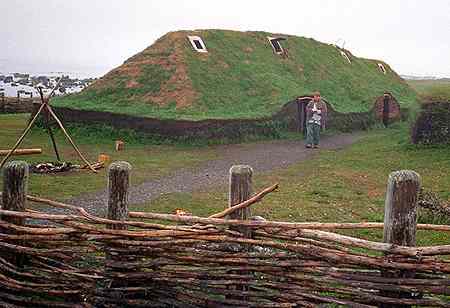 |
Norse History. The Norse voyages to North America are described in two Icelandic sagas, Eiríks saga rauða, and Grænlendinga saga. The sagas say that in the year 985, the Icelander Bjarni Herjólfsson was blown off course on his way to Greenland and spotted a new land. Surprisingly, he didn't go ashore, but he did eventually return to Greenland to tell his story.
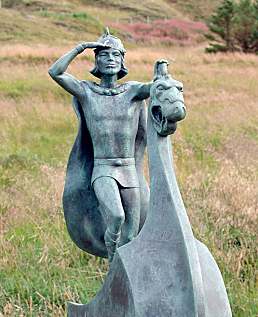 |
Leifur Eiríksson (left) decided to mount an expedition to this new land in 995. His first landfall was rocky and desolate, and he called it Helluland. The second landfall was forested, so he called it Markland. They wintered over at their third landfall. Because grapes and vines were found during explorations of the new land, Leifur called it Vínland. He returned to Greenland in the spring with a cargo of grapes and timber. |
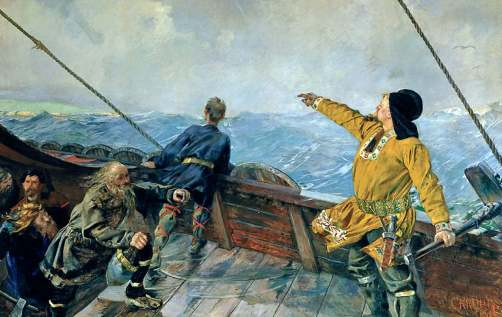 |
Some scholars have suggested that references in the sagas to vines and "vine berries" (grapes) and the cutting of vines may be a copyist's error in the manuscript. They suggest that instead of vín (wine), Leifur named the new land for vin (pasture land). This suggestion is not widely accepted. It seems unlikely that Leifur would have had much interest in more pasture, but he probably would have been very interested in wine, a high status drink of significant value. Regardless, the cargo of timber would have been a valuable commodity in treeless Greenland.
|
Leif's success in Vínland encouraged others to make the voyage. Þorvaldr Eiríksson made a voyage on which he was killed by an arrow shot by native Americans. He was buried at the site where he had hoped to settle in Vínland, and his crew returned to Greenland. Þorsteinn Eiríksson made an abortive trip, and he never reached Vínland. Perhaps the most elaborate expedition was the one led by Þorfinnur karlsefni. At least three ships were involved, and over 100 men and women joined the expedition. Þorfinnur brought a variety of farm animals and tools, intending to settle in Vínland, if he could. While in Vínland, Þorfinn's wife, Guðríður (right) gave birth to a son, Snorri, the first European child born in the new world. They sailed past Furðustrandir (Wonder Beaches) and wintered at Straumsfjörð, where they unloaded their cargo and livestock and settled in. The following year, they sailed further south, to Hóp. |
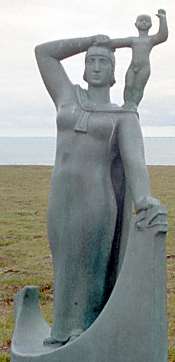 |
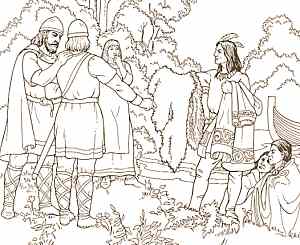 |
However, the expeditions ran into increasing difficulties with the native Americans, whom the Norse called skrælingjar (which might be translated "coarse fellows", or perhaps as "sub-humans"). At first, the skrælingjar were trade partners, trading their pelts and furs for dairy products and red cloth. The skrælingjar had never seen iron tools and weapons before, but must have realized their value. (Chapter 6 of Grænlendinga saga describes how one of the skrælingjar picked up an unattended Norse axe and struck and killed one his comrades. He then threw it out to sea as far as he could.) The Norse refused to trade their iron weapons for skrælingjar goods. |
The skrælingjar mounted increasing numbers of attacks on the Norse settlers, who realized they would be under constant threat of attack. Þorfinnur decided to return home. The number and severity of the attacks made the trading trips no longer worth the effort for the profits they returned to the Norse traders.
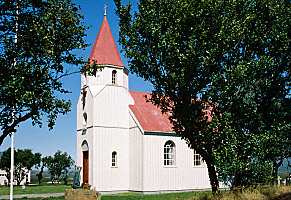 |
Þorfinn's men loaded their ships with their goods and a cargo of grapevines, berries, and skins, and they sailed back to Greenland. After wintering over in Greenland, Þorfinnur and Guðríður sailed to Iceland and farmed at Glaumbær, in the north, shown to the left as it appears today. The ruins of what may be Þorfinn's farm have recently been discovered in a field (right, at the end of the tire tracks). |
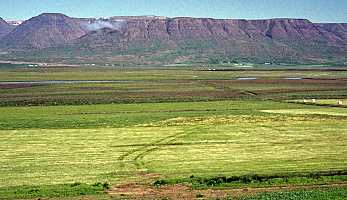 |
The small Greenland settlements were stretched beyond the limits of their ability to support a Vínland settlement that was several weeks' sail away. While individual Norsemen probably made irregular trips to Vínland for centuries, the days of regular trading visits were over.
Recent History. In the 1920's, the Newfoundland author W. A. Mann wrote The Wineland Voyages, suggesting that Vínland was located on the northern tip of Newfoundland. However, the suggestion seems to have been based mostly on speculation and guess work. The sagas do not contain enough detailed description to precisely locate Vínland. Further, the two sagas differ in some key details.
The Norwegian explorer and author Helge Ingstad began an intensive search for Norse sites in North America, beginning in New England and working his way northward along the coast. At L'Anse aux Meadows in Newfoundland, local residents were aware of mounds located in the peat bogs, but always assumed that they were Indian burial mounds. A local inhabitant, George Decker, led Ingstad to these mounds in 1960. For the next eight years, Ingstad, and his wife Anne Stine Ingstad led a team of international archaeologists in the excavation of the site. Rather than being an Indian burial ground, the mounds are the remains of a Norse community dating from approximately the year 1000. Further excavations by Parks Canada in the 1970s makes the conclusion incontrovertible.
The Site. The L'Anse aux Meadows site is not Vínland. Even counting the intervening climate changes, L'Anse aux Meadows is too far north to support the vegetation described in the sagas.
|
The L'Anse aux Meadows site was most probably a ship repair station, and a waypoint on the voyage to Vínland. The site contains the remains of three Norse longhouses used to house the ships crews. (The largest of these remains is shown in the photo to the right, and is about 20 meters (65 feet) long.) The remains of the walls clearly outline the floor plan of the buildings. |
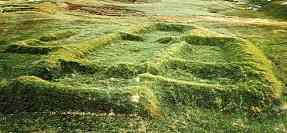 |
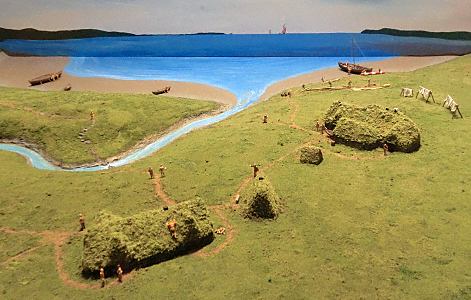 |
There are also the remains
of several workshops, probably used for woodworking, as well as
the remains of an iron forge, an iron smelter, and a charcoal
kiln. Also found on the site were a number of cut iron rivets
that probably had been removed from a ship. In addition, a supply
of new iron rivets were found, probably ready to be used for ship
repair. Many pieces of worked wood were found, as well as various
wood debris, probably from the carpenter shop. Some of the wood
had been worked into shapes appropriate for use on a Norse ship.
A bronze cloak pin of the type used by Norsemen was found, as well as a Norse stone oil lamp. A spindle whorl, used for spinning thread, was found, along with a bone needle, indicating that women occupied the site. Butternuts were found, which grow only in regions much further south. Butternuts and wild grapes grow in the same regions and ripen at the same time. The Norsemen who picked the butternuts in Vínland and returned with them to L'Anse aux Meadows may very well have picked grapes as well. Just as telling were some of the things not found. There is no sign of any garbage midden, indicating that the site was not occupied for long. The remains of the buildings show no signs of stone footings, indicating that the buildings were meant to be temporary. There are no signs of any burials, indicating that no one died while living at the site. There are no signs of domesticated animals or of agricultural activity, indicating that whatever the Norse residents of L'Anse aux Meadows ate, they either brought it with them, or else they hunted or gathered it on the spot. |
Taken together, the evidence points to a site used by the Norse on a regular basis for ship repair. The site was probably not occupied continuously. Since both men and women occupied the site, whole families must have traveled together on these voyages.
The rigid organization of the site suggests a carefully planned and controlled venture. From the site, one can see across the entire width of the Strait of Belle Isle, which leads to the Gulf of St. Lawrence. Because of its location, whoever controlled L'Anse aux Meadows also controlled the approaches to and the resources of Vínland. L'Anse aux Meadows was the gateway to the riches of Vínland.
The voyage from Greenland to Vínland probably took 9 to 14 days under favorable conditions. Due to drift ice in northern latitudes, the voyage couldn't start until mid-summer, but had to be completed by October. This window was too short to routinely make the round-trip voyage safely in one season. Thus, it is likely that ships wintered over in Vínland.
When the Norse occupied the site, it was a pleasant cove with a long, sandy beach. A handful of buildings were located about 100 meters from the high tide line around the cove. Just behind the buildings was a peat bog, with a stream flowing through it. To one side was a stand of timber. And off in the distance stood a low mountain range. Even from their ships in the cove, the Norse would have recognized this site as an ideal spot. It had a sheltered harbor, a favorable beach on which the ships could be landed, a ready supply of wood, and a near certain chance of the presence of bog iron and the other raw materials needed for smelting iron.
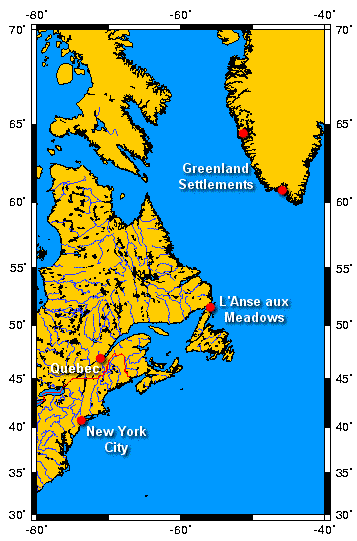 |
Where was Vínland? There is insufficient evidence at this time for anything other than a guess. The only North American site with indisputable evidence of a visit by Norsemen is L'Anse aux Meadows, at the northern tip of Newfoundland. It's possible that the L'Anse aux Meadows site is Leifsbúðir, where Leifur built his booths, and later, large houses, according to the sagas (Grænlendinga saga chapter 3). However, both literary and archaeological evidence implies that Norse visitors traveled further south, to warmer climates. Scholars have suggested sites for Leif's Vínland and for Þorfinn's Hóp in the Gulf of St. Lawrence, and along the St. Lawrence River as far inland as Quebec, as well as along the eastern seaboard of Canada and the United States as far south as New York City. Until additional evidence is found, we simply do not know. |
Wherever Vínland was, Norse visits to North America didn't stop with the three visits described in the sagas. It's likely that Greenlanders continued making the voyage to collect timber and other valuable trade items for centuries. The Icelandic records (Flateyjarbók) state that Bishop Eiríkr upsi Gnúpsson of Greenland went to Vínland in 1121. The record does not state whether he found it, or even if he returned. The last voyage reported in Icelandic historical documents (Skálholtsannáll) was in 1347, when a ship returning from Markland to Greenland was blown off course and landed in Iceland with seventeen men on board.
|
A coin found in Maine in 1957 at an important Native American archaeological site has been identified as a Norwegian coin from the 11th century (right). Perhaps it was lost or traded there during one of the later Vínland voyages. |
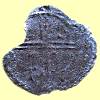 |
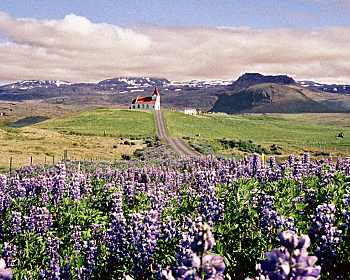 |
There is evidence that the Norse voyages to Vínland were known elsewhere in Europe. European authors wrote about Vínland, including Adam of Bremen. Some scholars suggest that knowledge of Vínland existed in European seaports in the 15th century. Christopher Columbus visited Ingjaldshöll (left) in Iceland in 1477, fifteen years before his historic journey to the New World. Whether he learned about Vínland from the Icelanders during his visit is pure conjecture. |
Today. L'Anse aux Meadows has changed during the 1000 years since Leif's visit. The climate is cooler, so there are few trees, and none of any size. The sea level has dropped and the land has risen, so the remains of the Norse buildings are some distance from the water.
|
The remains of the walls of the Norse buildings are unmistakable. They clearly outline the floor plan of the buildings. A modern reconstruction of a Norse longhouse has been built at the site, along with a visitor center housing the artifacts found at the site, and a representative sample of Norse artifacts from other sites. |
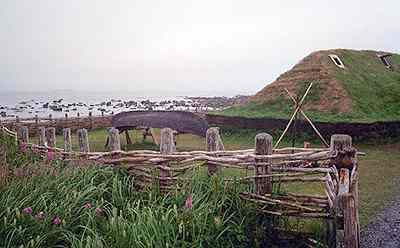 |
|
|
©1999-2025 William R. Short |